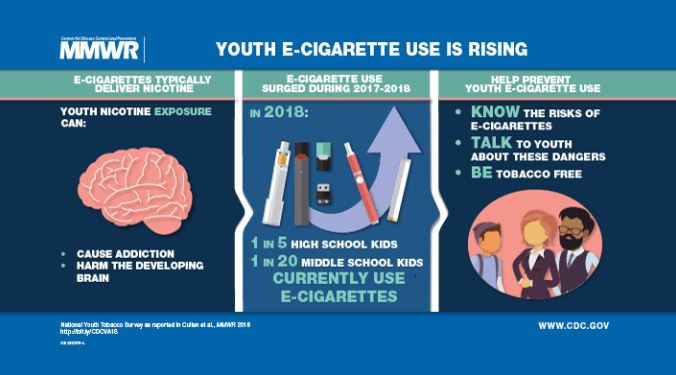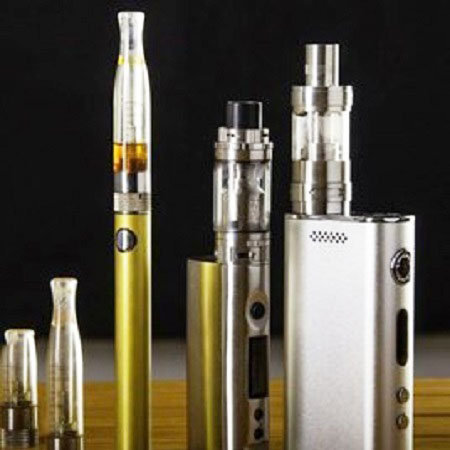E-Cigarette (Electronic Cigarette) or Electronic Nicotine Delivery System, known as "Vaping" is a handheld battery-powered vaporizer that actuates smoking, which comprises aerosol without burning tobacco. The user who smokes these kinds of cigarettes is known as a Vaper.
E-cigarettes typically have a boiling element that atomizes a liquid solution known as E-liquid. E-liquid usually contains many amounts of contaminants such as propylene glycerol, glycerin, nicotine, and flavorings.
E-cigarettes mostly consist of four different components, including a cartridge or reservoir, which holds a liquid solution named E-liquid, heating element, power source, and a mouthpiece.
Learn some of the facts of the E-cigarette below.
Popularity Of E-Cigarette
The E-Cigarette is still in its sizzling trend. The popularity of these e-cigarettes is massive and undeniably growing among adults and young ones. E-Cigarette appears to be in all places these days, and many reflect of them as a useful tool for people looking to quit smoking and comparatively risk-free for new users.
There are many ways of smoking these kinds of cigarettes. Normally users activate these cigarettes by taking a puff, whereas others turn on manually by pressing a button.
Many variations of these cigarettes are also included where some look like traditional cigarettes like regular cigarettes/cigar while others may come in pens and USB sticks. These kinds of E-Cigarette are normally reusable products, whereas some may be disposable.
The minimum ratio of nicotine in E-liquid ranges from 24 mg/ml, and below is deemed zero threat, whereas the maximum ratio of nicotine in E-liquid ranges from 36 mg/ml and above is considered as a serious high threat.

Parts of the second generation e-cigarette (©: commons.wikimedia.org)
The person who built an electronic smokeless device was Herbert A. Gilbert on America in 1965. Joseph Robinson brought the first concept of these smokeless devices in 1927. He submitted a patent for this electronic smokeless device in 1963.
The first kind of invention for non-tobacco cigarettes was free of nicotine, but instead, it had vapor, which had flavors to replace the smoke of tobacco. Hon Lik from China made the first modern E-Cigarette in the mid-2000.
E-Cigarette Addiction
There are many concerns regarding vaping users that using E-Cigarette is better or harmful? The benefits and health risks of E-Cigarettes are unclear.
The E-Cigarette is composed of many contaminants such as propylene glycerol, glycerin, nicotine, flavors, tiny amounts of toxicants, carcinogens heavy metals, and nanoparticles, which generate vapor made up of ultra-fine particles of a particular matter or also known as E-liquid.
The precise composition varies with the design of these e-cigarettes and contents of the liquid. The cigarette vapor theoretically contains harmful chemicals not found in tobacco smoke. It may contain less toxic and other harmful substances, but excessive use may cause other effects on the long terms health issues like lung cancer, coughing, nausea, vomiting, headache, and additional serious effects.

E-Cigarette addiction and its uses among students (©: cancer.org)
Whereas there is tentative evidence that E-Cigarette may help people quit smoking, although it has not been proven to be more effective than smoking reducing cessation medicine.
Adolescents who use E-Cigarette are more expected to go on to smoke cigarettes. E-Cigarette and other vaping devices would be a preferred alternative to traditional cigarettes when used entirely as a replacement and only among smokers who have been unable to quit smoking using confirmed medically approved methods.
However, there is limited proof that they constantly lead to smoking cessation. In fact, the nicotine contained in E-Cigarette and other vaping products may prolong addiction, in some cases, making it even harder to quit smoking.
In January 2018, the National Academy of Science, Engineering, and Medicine released a consensus study report stating that inhalation of harmful chemicals causes health risks of excessive use of e-cigarette’s that have irreversible lung damage and disease including other symptoms including mouth to neck irritation, vomiting, headache, and many more effects.
Additional research shows that vaping could lead to other types of cancers and other harmful symptoms like tachycardia, high blood pressure, seizures, and coma.
What Are The Health Risks Of E-Cigarettes?
Many people welcomed Vaping products as a theoretically non-toxic alternative to cigarettes, where millions of people have switched from cigarettes but also had attracted some new generations of nicotine addicts.
As per the report by the New England Journal of Medicine, high school students of 12th graders who used vaping increased dramatically from 2017 to 2019, doubling the rate of vaping users from 11% to 25%. While the consumption of e-cigarette has certainly increased, so did the health risks.
There were 195 separate cases of E-Cigarette triggering fire and explosion occurrences in the United States as reported by the media between 2009 and 2016, according to the report submitted by the U.S Fire Administration.
On 27 January 2019, at Fort Worth hospital, a man who resided in Texas, William Brown, died of a massive stroke when he was consuming the e-cigarette after it detonated and shredded his carotid artery vein. The medical examiner said that he deceased from cerebral infarction and herniation from the exploding vape pen that dissected his left carotid artery.
The incident occurred on the 27th of January in a parking lot after he purchased the smoking and vaping materials. The manager of smoke and vape DZ mentioned to CNN that he called an ambulance after the incident occurred. After the incident, he was hurried to the hospital for an emergency.

William Brown died from e-cigarette explosion on 27 January 2019 (© cnn.com)
His family informed KTVT, stating that he was placed into a medically induced coma, and x-rays revealed that part of the e-cigarette was wedged into his throat and stayed there. She was astounded why the doctors didn’t operate him immediately when he was rushed to the hospital.
A woman from the JPS health network mentioned to CNN that she could not remark on the details of Brown’s case because of health privacy laws and still communicating with his family while conveying their sincere condolences. She also mentioned that they maintain their high standards in providing high-quality healthcare and will take the utmost concerns about his family for what they had to go through from this incident.
Similar cases were found in May of 2019 when a man who resided in St. Petersburg, Florida, was killed when his e-cigarette was seen exploding, and a piece of the device pierced right through his head.
During mid-September 2019, Walmart took a major step to stop selling E-Cigarette at namesake stores and Sam’s Club locations due to increasing health anxieties around vaping, especially among young people. Walmart cited the reasons behind it were the increasing federal, state, and local monitoring complexity and uncertainty regarding e-cigarette was large at hand.
On 19 September 2019, U.S. health official’s mentioned that there were more than 530 confirmed cases of lung injury associated with vaping where eight people have already died.
Due to its health risks, Walmart mentioned to the regulators that it would increase the minimum age for buying tobacco products to 21 and would stop selling fruit and dessert-flavored cigarettes.
Not only Walmart but in the states of New York and Michigan, the Trump Administration has been moving toward banning flavored vaping products due to the increase in health anxieties.
On the other hand, pharmacy also restraints Rite Aid and Walgreen, stating that they should raise the tobacco buying age to 21. Rite Aid also mentioned that it would stop selling E-Cigarette and vaping products, whereas CVS stopped selling all tobacco products back in 2014.
Pros And Cons Of E-Cigarette
Some of the cons of vaping includes:
•The cigarettes contain nicotine and other substances, which targets the brain that makes adolescents more addicted due to flavors and other components. These cigarettes have both good and bad aspects that may likely affect the body and their future. Nicotine is still a mesmerizing drug. While not all E-Cigarette have nicotine, most do. Nicotine affects the neurotransmitters in the brain, producing addictive cravings and performance.
•Electronic cigarettes still produce carcinogens. E-Cigarette uses liquid nicotine, an extremely hazardous substance, even in small doses. Some challenging studies propose that some vaporizers release toxic metals during use.
•The manufacturing of these products is relatively intolerant. These products are not topic to FDA support, and, according to some experts, they have not been considered thoroughly enough to comprehend potential threats.
•The performance of smoking is habit-forming. Almost all experts approve that the physical activities related to smoking are habit-forming, without the help of tobacco or nicotine. This makes quarrels about E-Cigarette helping smokers prompt seem flawed, and also could encourage negative habits among previous non-smokers.
Some of the pros of vaping includes:
•E-cigarettes yield far fewer carcinogens than traditional cigarettes. Traditional cigarettes contain between 4,000 and 7,000 harmful chemicals, many of which are formed by the tobacco and smoke. Since E-Cigarette use vapor machinery, they expose users to lesser carcinogens, which makes the use of these cigarettes favorable and safe. Many studies have shown E-Cigarette to be considered useful in smoking cessation. In multiple studies and surveys, E-Cigarette has been shown to theoretically help smokers to decrease their habit or to quit altogether.
•The effects are far less harmful than traditional cigarettes. Though vapor exists, the levels of smoke and the consequences of “vaping,” which shows scales lower than conventional smoking.
•They are more generally acceptable and do not odor. E-Cigarette provides the same understanding and feeling for smokers, mainly those with nicotine habits, but can be used in far more places. They do not leave an adhesive, unfriendly odor and do not tint teeth or fingernails. They are a cheaper substitute to smoking. While this has not been lengthily researched, studies in the U.K. and the U.S. show that vaping habits can be up to 40 percent less exclusive than cigarette smoking habits.
•The department of US food and drug Administration (US FDA) stated that nicotine replacements products might be safer than E-Cigarette, whereas E-Cigarette is also seen safer than combusted tobacco products, which make their use similar to that of smokeless tobacco.

